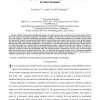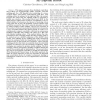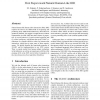CORR
2010
Springer
13 years 5 months ago
2010
Springer
Off-line robot dynamic identification methods are mostly based on the use of the inverse dynamic model, which is linear with respect to the dynamic parameters. This model is sample...
CORR
2010
Springer
13 years 5 months ago
2010
Springer
Abstract-- In this paper we present a method for automatically generating optimal robot trajectories satisfying high level mission specifications. The motion of the robot in the en...
CONNECTION
2008
13 years 5 months ago
2008
We introduce an approach for physically-grounded natural language interpretation by robots which reacts appropriately to unanticipated physical changes in the environment and dyna...
CORR
2010
Springer
13 years 5 months ago
2010
Springer
This paper presents three feedback controllers that achieve an asymptotically stable, periodic, and fast walking gait for a 3D bipedal robot consisting of a torso, revolute knees, ...
AROBOTS
2007
13 years 5 months ago
2007
Natural human-like human-robot interaction (NHL-HRI) requires the robot to be skilled both at recognizing and producing many subtle human behaviors, often taken for granted by hum...
AROBOTS
2007
13 years 5 months ago
2007
This research details the application of non-verbal communication display behaviors to an autonomous humanoid robot, including the use of proxemics, which to date has been seldom ...
AR
2007
13 years 5 months ago
2007
Abstract— Robot imitation is a useful and promising alternative to robot programming. Robot imitation involves two crucial issues. The first is how a robot can imitate a human w...
AR
2007
13 years 5 months ago
2007
—Reinforcement learning is the scheme for unsupervised learning in which robots are expected to acquire behavior skills through self-explorations based on reward signals. There a...
AR
2007
13 years 5 months ago
2007
Joint attention is one of the most important cognitive functions for the emergence of communication not only between humans but also between humans and robots. In the previous wor...
AROBOTS
2008
13 years 5 months ago
2008
Online trajectory generation for robots with multiple degrees of freedom is still a difficult and unsolved problem, in particular for non-steady state locomotion, that is, when th...



